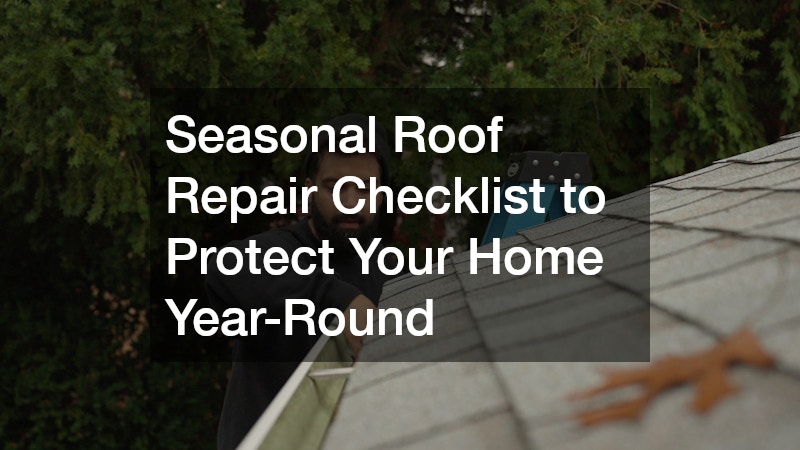Explore essential seasonal roof repair tips to help you maintain your home’s integrity throughout the year. Proper maintenance can prevent larger issues, ensuring your roof remains functional and secure in all weather conditions.
Why is Seasonal Roof Maintenance Important?
Prioritizing regular roof maintenance and timely roof repair can help homeowners prevent costly issues and prolong the lifespan of their roofs. Seasonal inspections allow you to catch minor issues before they escalate into significant problems that require expensive repairs.
A well-maintained roof not only protects your home from water damage and leaks but also enhances its overall structural integrity and aesthetic appeal.
Regular maintenance and roof repair can help you adhere to warranty requirements set by roofing manufacturers, making sure you don’t void your coverage. Many roofing materials require proof of upkeep in order to remain valid under warranty. By maintaining your roof seasonally, you’re also likely to increase your home’s resale value when it comes time to sell. Buyers are often willing to pay a premium for a property that has been well-maintained.
In addition, different seasons bring varying challenges, such as rain, snow, wind, and extreme temperatures. By addressing roof maintenance proactively, you can combat the wear and tear caused by each of these elements. For instance, during the winter months, accumulated snow and ice can lead to structural issues if not managed properly. This makes seasonal roof assessments an integral part of homeownership that shouldn’t be overlooked.
What Should You Check During Spring for Roof Maintenance?
Spring cleaning is not just for the interior of your home; your roof needs attention, too. Here are key checks to perform in the spring. Start by removing any debris that has accumulated over the winter, including leaves, twigs, and dirt. This debris can trap moisture, leading to the growth of mold and algae on your roof, which can eventually deteriorate your roofing material.
Next, inspect shingles for signs of damage. Look for any cracks, missing pieces, or curling edges. If shingles are compromised, they can allow water to seep beneath, leading to leaks and further damage. Addressing these issues promptly with proper roof repair helps protect your home from costly problems down the line. Make sure to also check flashing around chimneys and vents, as this area is typically more vulnerable to leaks due to its configuration. If the flashing is rusted, damaged, or missing, replacing it immediately is crucial to prevent subsequent damage.
Don’t forget to assess your gutters and downspouts. Make sure they’re clear of blockages and functioning correctly. Blocked gutters can overflow and cause water to back up onto the roof, leading to potential leaks and rot.
How to Prepare Your Roof for Summer Weather?
With the heat of summer, making sure your roof is ready to handle high temperatures and potential storms is vital. Start by checking the insulation and ventilation of your roof to keep your attic cool and prevent heat buildup. Proper ventilation will also help reduce the risk of condensation, which can lead to mold issues and decreased energy efficiency in your home.
Next, inspect your roof for any signs of wear that may have been exacerbated during spring storms. Check for cracked tiles, warped shingles, or issues with flashing that could lead to leaks during summer thunderstorms. If any issues are found, consider repairing them promptly to avoid more extensive roof repair problems later. Preventative measures during this high-stress season can prolong the life of your roof.
Consider applying reflective coatings, which can help to lower roof temperatures and reflect harmful UV rays that can degrade roofing materials. Additionally, if you live in an area prone to summer storms, it might be beneficial to invest in roof straps or systems designed to help secure your roof against high winds.
What Roof Repairs Are Necessary in Fall and Winter?
As the temperatures drop, it’s important to make necessary repairs before winter weather sets in. Start by conducting a thorough inspection of your roof to identify any problem areas. Look for missing or damaged shingles that could allow water to infiltrate your home when the first snow begins to fall. Repair any compromised areas urgently to safeguard your home against winter weather.
Also, pay special attention to gutters and downspouts as they play a crucial role in directing melting snow and rain away from your foundation. Clean out any debris that may have accumulated and ensure that they are securely attached and routed properly. Proper drainage is crucial in preventing ice damming, which can occur when melted snow refreezes at the edge of your roof, leading to leaks and structural damage that often require roof repair.
Finally, it’s wise to schedule a professional evaluation, especially if you live in an area that experiences heavy snowfall. Roofing experts can assess the integrity of your roof and advise on any additional precautions or roof repair that might be necessary to keep your home protected through the winter.
Regular roof inspections and maintenance throughout the year not only protect your home from the elements but also save you money in the long run. By following this seasonal checklist, you can ensure your roof remains in good condition year-round. Consistent attention to your roof can mitigate future complications and enhance the overall longevity of your investment. So, take the time each season to assess your roof and address any potential issues.





